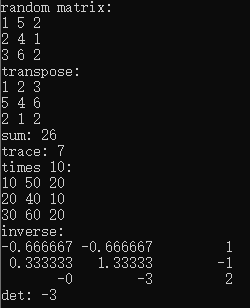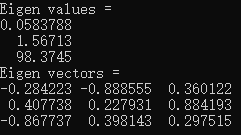Eigen是一个高层次的C ++库,支持线性代数,矩阵和矢量运算,数值分析及其相关的算法。本例程包含头文件:
#include <iostream>
using namespace std;
#include <ctime>
// Eigen 核心部分
#include <Eigen/Core>
#include <Eigen/Dense>
using namespace Eigen;
#define MATRIX_SIZE 51、变量声明
Eigen 中所有向量和矩阵都是Eigen::Matrix,它是一个模板类。它的前三个参数为:数据类型,行,列。
1)声明一个2*3的float矩阵
Matrix<float, 2, 3> matrix_23;2)内置类型
Eigen 通过 typedef 提供了许多内置类型,不过底层仍是Eigen::Matrix。
Vector3d v_3d; // 等价于Eigen::Matrix<double, 3, 1>,即三维向量
Matrix3d matrix_33; // 等价于Eigen::Matrix<double, 3, 3>,即三乘三矩阵如果不确定矩阵大小,可以使用动态大小的矩阵:
Matrix<double, Dynamic, Dynamic> matrix_dynamic;
MatrixXd matrix_x; // 更简单点2、初始化
Eigen 中所有向量和矩阵都是Eigen::Matrix,它是一个模板类。它的前三个参数为:数据类型,行,列。
Matrix3d::Zero(); // doubel类型,3*3全零矩阵
Matrix3d::Random(); // doubel类型,3*3随机数矩阵矩阵赋初值:
Matrix3d matrix_33 = Matrix3d::Zero(); //初始化为3*3全零矩阵赋值,显示:
// 输入数据(初始化)
Matrix<float, 2, 3> matrix_23;
matrix_23 << 1, 2, 3, 4, 5, 6;
// 输出
cout << "matrix 2x3 from 1 to 6: \n" << matrix_23 << endl;
// 用()访问矩阵中的元素
cout << "print matrix 2x3: " << endl;
for (int i = 0; i < 2; i++)
{
for (int j = 0; j < 3; j++) cout << matrix_23(i, j) << "\t";
cout << endl;
}结果:

3、矩阵运算
定义变量:
Matrix<float, 2, 3> matrix_23; // 2*3矩阵,float
matrix_23 << 1, 2, 3, 4, 5, 6;
Vector3d v_3d; // 3*1向量,double
v_3d << 3, 2, 1;
Matrix<float, 3, 1> vd_3d; // 3*1向量,float
vd_3d << 4, 5, 6;在Eigen里不能混合两种不同类型的矩阵,这样语法是错误的。
Matrix<double, 2, 1> result_wrong_type = matrix_23 * v_3d;同样不能搞错矩阵的维度,这样语法是错误的。
Eigen::Matrix<double, 2, 3> result_wrong_dimension = matrix_23.cast<double>() * v_3d;矩阵显示调用:
// 2_3*3_1 = 2_1
Matrix<double, 2, 1> result = matrix_23.cast<double>() * v_3d;
cout << "[1,2,3;4,5,6]*[3,2,1]=" << result.transpose() << endl;
Matrix<float, 2, 1> result2 = matrix_23 * vd_3d;
cout << "[1,2,3;4,5,6]*[4,5,6]: " << result2.transpose() << endl;4、矩阵运算
一些矩阵运算,四则运算就不演示了,直接用+-*/即可。
Matrix<float, 3, 3> matrix_33; // 随机数矩阵
matrix_33 << 1, 5, 2, 2, 4, 1, 3, 6, 2;
cout << "random matrix: \n" << matrix_33 << endl;
cout << "transpose: \n" << matrix_33.transpose() << endl; // 转置
cout << "sum: " << matrix_33.sum() << endl; // 各元素和
cout << "trace: " << matrix_33.trace() << endl; // 迹
cout << "times 10: \n" << 10 * matrix_33 << endl; // 数乘
cout << "inverse: \n" << matrix_33.inverse() << endl; // 逆
cout << "det: " << matrix_33.determinant() << endl;结果:

5、特征值,对角化
对角化,求解特征值。
Matrix<double, 3, 3> matrix_33;
matrix_33 <<1, 5, 2, 2, 4, 1, 3, 6, 2;
// 对角化
SelfAdjointEigenSolver<Matrix3d> eigen_solver(matrix_33.transpose() * matrix_33);
// 求解特征值
cout << "Eigen values = \n" << eigen_solver.eigenvalues() << endl;
cout << "Eigen vectors = \n" << eigen_solver.eigenvectors() << endl;结果:

6、解方程
求解 matrix_NN * x = v_Nd 这个方程,N的大小在前边的宏里定义,这里N=50,它由随机数生成。
Matrix<double, MATRIX_SIZE, MATRIX_SIZE> matrix_NN
= MatrixXd::Random(MATRIX_SIZE, MATRIX_SIZE);
matrix_NN = matrix_NN * matrix_NN.transpose(); // 保证半正定
Matrix<double, MATRIX_SIZE, 1> v_Nd = MatrixXd::Random(MATRIX_SIZE, 1);1)直接求逆自然是最直接的,但是求逆运算量大。
clock_t time_stt = clock(); // 计时
// 直接求逆
Matrix<double, MATRIX_SIZE, 1> x = matrix_NN.inverse() * v_Nd;
cout << "time of normal inverse is "
<< 1000 * (clock() - time_stt) / (double)CLOCKS_PER_SEC << "ms" << endl;
cout << "x = " << x.transpose() << endl;2)通常用矩阵分解来求,例如QR分解,速度会快很多。
time_stt = clock();
x = matrix_NN.colPivHouseholderQr().solve(v_Nd);
cout << "time of Qr decomposition is "
<< 1000 * (clock() - time_stt) / (double)CLOCKS_PER_SEC << "ms" << endl;
cout << "x = " << x.transpose() << endl;3)对于正定矩阵,还可以用cholesky分解来解方程。
time_stt = clock();
x = matrix_NN.ldlt().solve(v_Nd);
cout << "time of ldlt decomposition is "
<< 1000 * (clock() - time_stt) / (double)CLOCKS_PER_SEC << "ms" << endl;
cout << "x = " << x.transpose() << endl;结果:
x = -0.177629 0.179189 7.66884e-05 -0.493822 0.568221版权声明:本文为weixin_34910922原创文章,遵循CC 4.0 BY-SA版权协议,转载请附上原文出处链接和本声明。